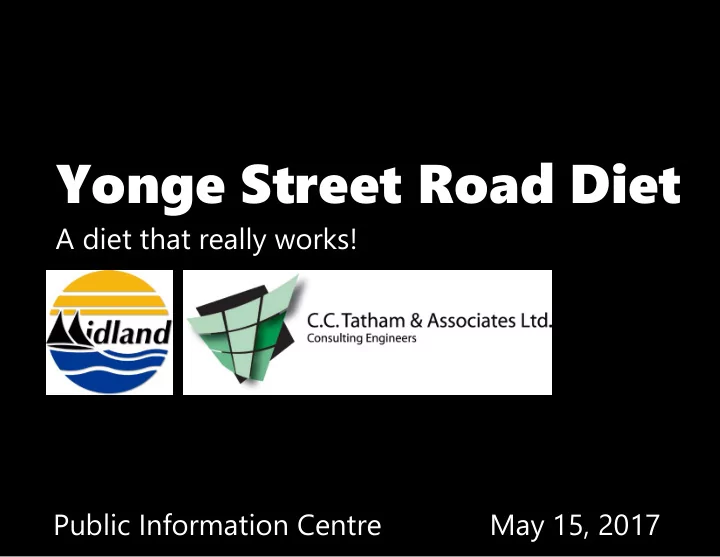

Yonge Street Road Diet A diet that really works! Public Information Centre May 15, 2017
Overview 1. What is a road diet? 2. Why not consider a road diet? 3. Why consider a road diet? 4. When is a road diet desirable? 5. The Yonge Street corridor 6. Can a road diet work on Yonge Street? 7. Implementing the road diet
1. What is a road diet? The conversion of a 4-lane undivided road to a 3-lane undivided road with a centre two- way left turn lane (TWLTL)
1. What is a road diet?
2. Why NOT consider a road diet? Possible drawbacks might include loss of passing opportunities increased delays at unsignalized access points during busy periods increased travel delays during busy periods impacts to transit impacts to curb-side services
3. Why consider a road diet? Improved safety at mid-block locations reduction in vehicle conflicts fewer lanes dedicated bike lanes protected left turns
3. Why consider a road diet? Improved safety at intersections reduction in vehicle conflicts fewer lanes dedicated bike lanes protected left turns
3. Why consider a road diet? Improved safety with better visibility improved sight lines easier to make a left turn easier to see pedestrians & cyclists crossing
3. Why consider a road diet? Reduce or eliminate certain collision types
3. Why consider a road diet? Reduce or eliminate certain collision types
3. Why consider a road diet? Reduce or eliminate certain collision types
3. Why consider a road diet? Improved safety with lower speed differentials vehicle speeds can vary on 4 lane roads drivers slow or change lanes due to turning vehicles drivers may weave between lanes at high speeds
3. Why consider a road diet? Operational benefits separates left turns improved entry/crossings for side-street traffic speed differential reductions
3. Why consider a road diet? Pedestrian & cyclist benefits reallocate space from travel lanes to bike lanes or sidewalks slower speeds shorter crossings Health Care Foundation Greater Kansas City
4. When is a road diet desirable? As per the Road Diet Information Guide a number of factors should be considered safety slow & stopping vehicles speed of travel loading/unloading level of service vehicles quality of service on-street parking traffic volumes at-grade crossings turning volumes pedestrians & cyclists
5. Yonge Street corridor Intersections & Traffic Control 3 signalized intersections N 17 stop control intersections Intersection Pedestrian Signal (IPS) signalized intersection unsignalized intersection source: Simcoe Maps
5. Yonge Street corridor Development & Access primarily single family lots with driveway access some commercial & institutional uses 65 driveways on the north side, 48 on the south sidewalk on both sides
5. Yonge Street corridor traffic operations traffic volumes Midland Transit 10,000 to 14,000 operates in the WB vehicles per day direction currently SCDSB bus service 16,000 to 21,000 in the 2037 horizon garbage/recyclables/ compost collection
6. Can a road diet work on Yonge St? Appropriateness of road platform road is of sufficient width to accommodate: bike lanes 1 travel lane per direction centre turn lane 1.5m 3.5m 14.0m road width 3.5m 3.5m 4.0m 3.5m 3.5m 3.5m 1.5m
6. Can a road diet work on Yonge St? Appropriateness of traffic volumes road diets have been successfully implemented on roads serving 25,000 vehicles per day current traffic volumes 10,000 to 14,000 vpd 20 year traffic volumes 16,000 to 21,000 vpd
6. Can a road diet work on Yonge St? Appropriateness of traffic operations AM PM AM PM 15s 12s 28s 30s B B D D delay & level of service Fourth St Eighth St AM PM AM PM 15s 16s 17s 18s B B C C
6. Can a road diet work on Yonge St? Appropriateness of intersections signalized intersections are sufficiently spaced to avoid queue issues only 2 instances of offset unsignalized intersections whereby lefts may overlap, but not considered critical
6. Can a road diet work on Yonge St? Improvements to cyclist & pedestrian facilities bicycle lanes will have benefits to cyclists & the Town’s Active Transportation program bicycle lanes will also provide buffer to the sidewalks
6. Can a road diet work on Yonge St? ? Impacts to transit & other services all vehicles will share a single travel lane increased potential for delays stemming from curb-side services
6. Can a road diet work on Yonge St? The Town must consider their priority Improve Move traffic with traffic & minimum pedestrian safety delay while and accept maintaining higher safety acceptable traffic risks flow for other users
7. Implementing the road diet Functional plans have been prepared to illustrate: the conversion from 4 to 3 lanes with bike lanes the phasing limits the transitions at the project limits Simcoe Road 93 Eighth Street King Street Yonge Street Phase 2 Phase 1
7. Implementing the road diet Functional plans
Questions
Recommend
More recommend